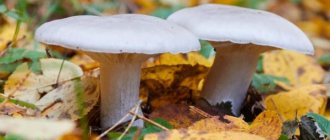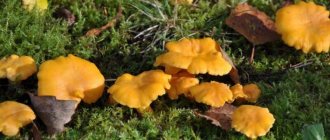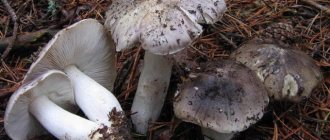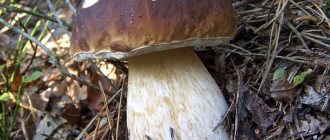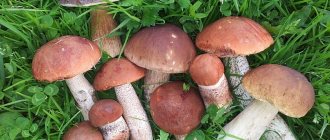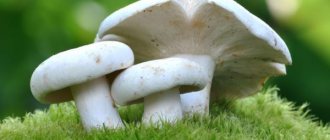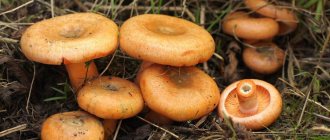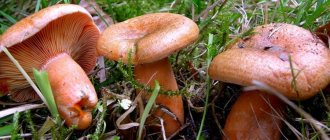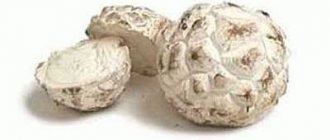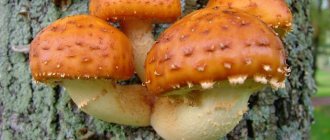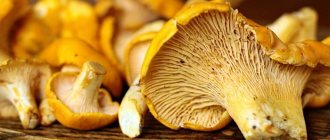Milky mushrooms
The main feature of such mushrooms is the lack of fiber. When broken, most of them release juice or white milk. For many of them it is poisonous. Therefore, in Europe these mushrooms are considered inedible, while in Russia many people collect them and happily eat them salted or pickled. Before cooking, they must be soaked and then boiled in salted water. In addition to saffron milk cap and milkweed, milkweeds include: milk mushrooms, rubellas, serushkas, and spurge. The main habitat for these fungi is wet, wetlands. They can be found both in birch and mixed forests, and in spruce forests.
The most common species found in Russian forests are saffron milk cap and roseate, which have much in common, but at the same time are noticeably different.
Description and characteristics of mushrooms
To understand the difference between volushki and saffron milk caps, you should familiarize yourself with their photos and detailed descriptions.
Saffron milk caps
Among milkweeds, saffron milk caps are considered the highest quality and tastiest. They include several types:
- real;
- spruce;
- hog;
- milky red.
Milky red and boron are classified as lamellar. The habitat of these two species is mixed forest. Spruce milkweed can be found in forests where spruce trees grow.
The saffron milk cap has a bright yellow or yellow with a red tint. It looks quite dense and strong. The funnel-shaped cap has a round shape, and its diameter varies between 5-18 cm. Concentric areas of dark color can be seen on the cap. The surface of the hat is slippery, and after rain it becomes sticky to the touch. The brittle leg has the same color as the cap. The shape of the leg is cylindrical, and after the camelina matures, the leg becomes hollow.
Camelina milky red
The pulp also has an orange tint, which first turns red when cut and then turns green. The plates are located frequently and have a lighter color. When pressed, the plates turn noticeably green.
Real saffron milk cap has distinctive features:
- shiny, slightly damp cap;
- the color of the top layer can be yellow, red-brown, reddish or orange;
- the surface of the mushroom has concentric circles, and sometimes you can notice a light coating;
- young fruits have a convex cap, which over time becomes flat or concave.
Real
saffron milk cap The raw pulp has a pleasant taste and a slightly fruity aroma.
Volnushki
Very often, lovers of quiet hunting in spruce and birch forests find mushrooms similar to saffron milk caps - these are pink volnushki. They got their name from the word “vovna”, because a barely noticeable fluff grows on their caps. They can be found in forests with sandy and siliceous soil, most often under birch trees.
The mushroom cap grows 1.5-10 cm wide. In young specimens it is convex, and with age it becomes concave with the edges turned inward. The cap is covered with thick hairs, which gives the wave a beautiful appearance.
The color of the cap is light pink, sometimes with a yellow or gray tint. Wide circular stripes are clearly visible on it. The pulp is pale pink in color, and to the touch it is very dense and dry. The densely arranged plates are the same color as the cap, but somewhat lighter. The juice is yellow-white.
Plates and milky juice of the mushroom
The pale leg reaches 5 cm in height. It is smooth, dense, and sometimes has small dark dents. It happens that with age the leg becomes hollow.
Not everyone likes the taste of cooked mushrooms. Raw volukhas are very pungent, but when cooked this taste disappears, although a slight pungency remains. The bitterness of the mushroom disappears after cooking.
Similar characteristics of the two types
Both species are close relatives, because they belong to the same genus. The juice of these mushrooms is considered poisonous in most countries, but in our country mushrooms are collected with pleasure and consumed pickled and salted.
Volnushka pink
The first similarity between these two species is that both live in birch groves and spruce forests. At the same time, they can grow next to each other, which confuses novice mushroom pickers. Externally, the mushrooms are very similar, because the mushroom can have either a pink or an orange-tinged cap. Both mushrooms have concentric circles on it.
Under the cap of these mushrooms there are densely spaced plates that are lighter in color than the surface of the mushroom. Most often, mushroom pickers are lost at the sight of young mushrooms, because both species have convex caps during this period.
The main differences between saffron milk caps and saffron milk caps
Despite the fact that they belong to the same family, there are a number of differences between saffron milk cap and volnushka. Let's compare them and find out what the main differences are:
- Color. The saffron milk caps have a bright pink tint, while the saffron milk caps are orange.
- Also, saffron milk caps have a shaggy cap, while saffron milk caps have a smooth cap.
- When broken, white milk is released from saffron milk caps, while saffron milk caps have a bright orange color.
- When heat treated, the pink volnushka changes color to light gray, and the camelina darkens.
- The inner surface of the saffron is light pink, while the saffron milk cap can vary from bright orange to green-blue. It depends on the age of the mushroom.
- Volnushka is considered a more unpretentious mushroom and grows mainly in birch groves. Finding saffron milk caps in the forest is a real find, since this mushroom likes to grow only in ecologically clean forests. By the way, you can only find it in pine or spruce forests.
- Another striking feature of the pink wave is the presence of clearly visible circles on the cap.
- Ryzhiki are mostly delicious mushrooms. Many even claim that their taste is superior to the much-vaunted porcini mushrooms and milk mushrooms. In addition, saffron milk caps do not require long soaking before cooking. In the old days they were even consumed fresh.
- Volnushki are the most commonly found mushrooms, along with russula. Before cooking, they need to be soaked for a long time in cold water; it is better to leave them for several days.
- These mushrooms also differ in size. The saffron milk caps are larger.
- When cut, the pink volnushka does not change its color; in the saffron milk cap it becomes greenish-blue.
Differences in primary processing
It is easier to wash and process volnushki. But the harvested harvest of these milkweeds must be soaked for about three days until the bitterness goes away. At the same time, the water is changed periodically. Only after soaking can they be used for pickling and boiling. Even from the time of salting, they wait no less than 1.5 months. But then there are few mushrooms tastier than pink trumpet mushrooms.
Pink volnushka is usually used for pickles or pickling. Before harvesting procedures, these mushrooms are soaked and blanched for a long time. Otherwise, these representatives of the mushroom kingdom will be bitter and somewhat toxic. So you should remember that the danger of being poisoned by these milkweeds is still great. Although this mushroom is not deadly, it can cause harm to health, causing vomiting, headaches and other unpleasant symptoms.
This will happen if the wave is prepared incorrectly. It can also cause gastrointestinal upset. Therefore, if a person is unfamiliar with this mushroom and the technology for its processing, it is better to refuse it. Ryzhiki can be used almost immediately. In addition, these milkweeds do not need to be soaked; they can also be fried.
In addition to everything, the mushroom also contains a very large amount of chitin, which reduces the benefits of the mushroom to zero. Saffron milk caps have almost no such substance.
Beneficial features
Many people compare the benefits of eating vodka with saffron milk caps. However, their beneficial properties are slightly different.
Volnushki
They contain large quantities of vitamin A, which has a beneficial effect on vision. In addition, these mushrooms are recommended by all nutritionists, since their calorie content is very low. They also contain essential amino acids for the body, vitamins B and C, necessary for hair and skin cells.
Saffron milk caps
They contain beta-carotene, which is essential for vision. Fiber regulates digestion. Minerals have a beneficial effect on the condition of skin and hair. In addition, these mushrooms contain the valuable antibiotic lactarioviolin, so it is often used to treat inflammatory diseases caused by bacteria and viruses.
How to distinguish the saffron mushroom from the toadstool
Only novice mushroom pickers can confuse saffron milk caps with toadstool. Therefore, it is better for them to go into the forest with experienced mushroom picking specialists in order to gain some experience themselves. Thanks to the following description, you can learn how to distinguish the saffron mushroom from the toadstool.
In appearance, it is sometimes difficult to distinguish the toadstool from some edible mushrooms. The cap of the fruiting body is yellowish, pale green or even olive in color. The center is darker in color and the edges are lighter. The shape of the cap resembles a funnel, but the toadstool has no curves downwards. The stem of the mushroom is thin and oblong, with an extensive white skirt located immediately under the cap. At the base, the toadstool's leg seems to stick out from the glass. It is these distinctive features that help identify the toadstool and not confuse it with saffron milk cap.
Contraindications
In general, mushrooms are a rather heavy food and are not equally beneficial for everyone. Therefore, before using them, you need to familiarize yourself with the contraindications. So, it is not recommended to eat saffron milk caps and red mushrooms if you have:
- Diseases of the gastrointestinal tract.
- Cholecystitis and other liver diseases.
- Kidney diseases.
- Constipation.
- Pancreatitis.
- Low acidity.
In addition, their use is prohibited during pregnancy and lactation, and they should not be given to children under 5 years of age. Children from 5 to 14 years old - only occasionally and after good heat treatment.
It should be remembered that mushrooms are capable of absorbing and accumulating toxins, so they can only be collected in clean places. Despite their good chemical composition, they should be consumed carefully in small quantities.
How to distinguish the saffron mushroom from the boletus mushroom: characteristic signs
Even a novice mushroom picker can answer how to distinguish a saffron mushroom from a boletus mushroom. Characteristic features are the massive body of the boletus and a rounded cap that resembles a pillow. The leg is very thick, widened downward, covered with small scales. Under the cap there is a tubular hymenophore of golden or olive color. The tubes are located very tightly, and when pressed or cut they acquire a bluish tint. Boletuses can be found in large groups and single specimens that grow in deciduous and coniferous forests.
How to distinguish a white trumpet from a milk mushroom
How to distinguish milk mushrooms from milk mushrooms and what are these differences? If we consider all the external signs of milk mushrooms and milk mushrooms, then upon careful study it is quite difficult to confuse them. How to distinguish white frogs from white milk mushrooms by their caps and legs?
- The caps of white trumpets are much smaller than those of milk mushrooms. The diameter of the cap of a milk mushroom can be up to 20 cm, while that of a milk mushroom is only up to 12 cm, sometimes up to 15 cm. The surface is clean, but that of a milk mushroom is dirty with particles of soil or litter.
- Although the flesh of mushrooms is white and releases milky juice when broken, only the mushroom does not change color and does not release a smell. But the juice of milk mushrooms when cut becomes yellow and emits a pronounced fruity aroma.
How else can you distinguish Volushka mushrooms from milk mushrooms? The volnushka has concentric circles on the surface of the cap, which are formed by thick fibers. However, in adulthood, the mushrooms lose their hairiness: they become colorless, the plates acquire a yellowish tint, which, in combination with the shape of the cap, is mistaken by novice mushroom pickers for signs of milk mushrooms. Therefore, it is quite easy for a beginner to confuse these two types.
Another description of some of the features of these mushrooms will show how to distinguish a found mushroom from a milk mushroom. For example, the first species has pubescence on the cap, but it can be seen mainly at the edges, and the cap itself is slimy and wet.
It is worth saying that although the volushka looks like a milk mushroom, it has never been an “official” milk mushroom. However, due to its taste, experienced mushroom pickers constantly include it in the list of fruiting bodies that are prepared for the winter. It is not worth neglecting the white trumpet, giving preference only to milk mushrooms. This mushroom is great for pickling and pickling for the winter.
Ryzhiki and volnushki, how to cook. How to salt volushki correctly
You can salt volushki in different ways, including cold. If the salting technology and recipe are not violated, there is no risk of poisoning for lovers of salted fish, otherwise the result may be different. Therefore, it is necessary to follow the technology. In addition, in order for the winter snack to turn out beautiful, tasty and appetizing, you need to take into account a number of points.
- Like all other mushrooms, before salting, the mushrooms need to be thoroughly cleaned of debris, insects, adhering blades of grass, and leaves. It is convenient to do this with a toothbrush. They do not have a film, which simplifies the process of preparing for salting, however, when cleaning and washing the wolves, housewives face another difficulty: the wolves are fragile, and if you press on them, even lightly, they begin to crumble in your hands.
- Experienced mushroom pickers recommend salting pink and white mushrooms separately, therefore, while sorting through the mushrooms and clearing them of debris, they must also be sorted. When sorting, the size of the mushrooms is also taken into account: large ones are put into another pile or cut into 2-4 parts.
- The waves are bitter. If you don’t soak them in cold water and salt before cooking, the bitterness will remain and you won’t want to eat salted mushrooms. Soak the waves for at least two days, changing the water periodically. This should be done at least 5 times a day. Otherwise, the mushrooms will begin to sour.
- When soaking, you need to make sure that the water completely covers the mushrooms, otherwise they will become moldy, and even if you rinse them well afterwards, there will be no guarantee that you were able to completely get rid of the mold.
- If the volushki are supposed to be salted in a cold way, then they are soaked not just in cold water, but with the addition of salt (50 g per liter) and citric acid (2 g per liter).
